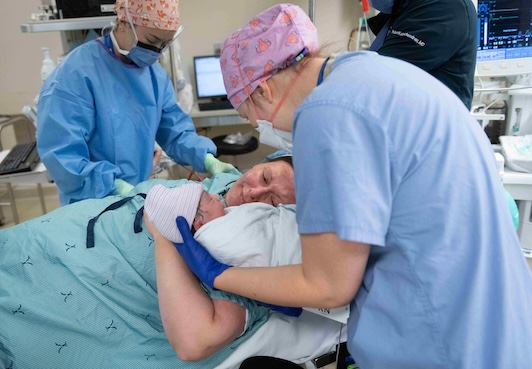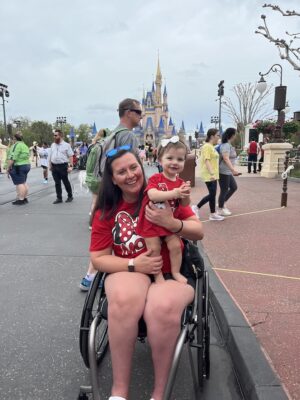Overcoming Challenges: Pregnancy for Patients with Disabilities

Like many parents, Diana Drake updates social media frequently with photos of her daughter, Ryan, who is almost one year old. From a trip to Disney World to her first steps, there’s lots to celebrate.
The photos are particularly poignant as, just a few years ago, Diana didn’t think a pregnancy was possible after an ATV accident. “I broke my back in two places and was paralyzed,” says Diana. “I was worried my lifelong dream to become a parent wasn’t possible.”
Last year, Diana did become pregnant, and received care from Sunnybrook’s Accessible Care Pregnancy Clinic. Now, experts from the clinic have partnered with the Provincial Council for Maternal and Child Health to create the ‘Disability and Pregnancy: Accessible Pregnancy Care Planning Toolkit’, aimed at helping healthcare professionals address the unique challenges faced by pregnant individuals with physical disabilities.
“At the heart of this resource is encouraging healthcare teams to think ahead and pre-plan to ensure the best possible outcomes and experience for patients,” explains Dr. Anne Berndl, Director of Sunnybrook’s Accessible Care Pregnancy Clinic. “Individualized care is key, as each disability can impact a pregnancy differently.”
The audience for the resource, available on PCMCH’s website, is sweeping and includes primary care providers, obstetricians, midwives, nurses, occupational and physical therapists, social workers, physiatrists, neurologists, pain medicine specialists, anaesthetists, lactation consultants, dietitians and others involved in all stages of prenatal, labour and delivery and postpartum care.
A key focus is making sure there’s a coordinated team approach to prenatal, birthing and postpartum care. “Before a patient even visits Sunnybrook, we have a long phone call with them to learn about their disability, their fears and what would help them,” says Liz Jung, an advanced practice nurse with the clinic. “We also keep in mind practical considerations, like whether they will need more time to visit the washroom at the hospital.”
Once the initial call with a patient takes place, Dr. Berndl and Jung encourage practitioners to work with all of the multidisciplinary teams who will support the patient as early as possible.
Many people with disabilities can have healthy pregnancies; however, there is an increased risk of adverse outcomes for pregnant individuals and their babies, including preterm birth, preeclampsia and Caesarian delivery. On top of this, there are significant barriers to accessing prenatal care for people with physical disabilities, including transportation complexities, lack of accessible care spaces and difficulties finding physicians comfortable providing obstetrical care.
“As healthcare practitioners, we can do a lot to take worry and anxiety away for patients by preparing early, coordinating the right care team and asking the right questions. This toolkit provides a framework for this model of care,” she adds.
Jung agrees, and acknowledges while some clinical settings may not have numerous resources, it comes back to the ‘small things’ like taking the time to have conversations with patients and embodying a person-centred approach for individualized care.
“People with disabilities are experts in their own lives and own care,” says Jung. “Whenever I meet with a new patient, I always ask, ‘I know your diagnosis, but I don’t know what that means to you. What would be helpful for you?’”

Diana can attest firsthand that the approach works well, and appreciated the longer intake appointment. She recalls Jung asking her about how she would be getting to appointments, her comfort moving in and out of her wheelchair, what her daily routine was like and any worries or fears she had.
“The time spent chatting at the onset really set my mind at ease for what was to come,” says Diana. “She wanted to get to know me, what my day-to-day was like and the supports I have. I also appreciated the coordinated care – all of the team were talking to each other about my pregnancy and delivery. It meant a lot.”
The team behind the toolkit urge care teams to think outside of the box and be creative. Jung gives the example of a patient using a wheelchair, and notes sometimes you can perform a fetal ultrasound while the patient is still sitting in their wheelchair.
“Hearing ‘We will take care of you, we will build a plan with you, and we are happy for you’, is such a simple but powerful statement to patients,” adds Dr. Berndl.
Both Sunnybrook and PCMCH say the collaboration was positive and productive. “This resource aims to pave the way for improved care experiences for pregnant individuals concurrently living with physical disabilities. We hope that this toolkit will be widely embraced in all care settings, transforming the landscape of healthcare, and ensuring quality care for every individual in Ontario and beyond,” Alexandra Thorp, Senior Program Manager, PCMCH.
By Marie Sanderson








